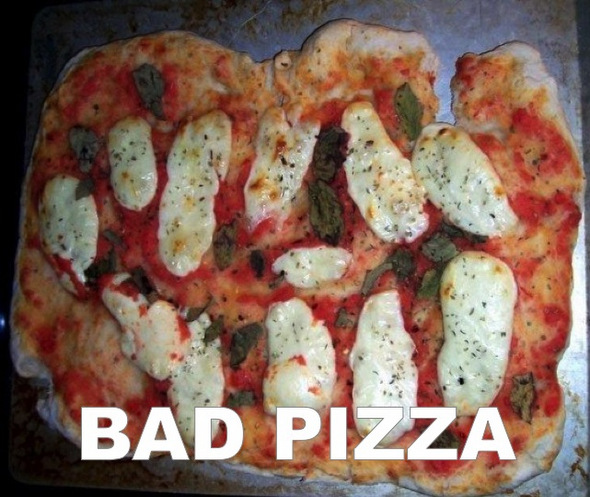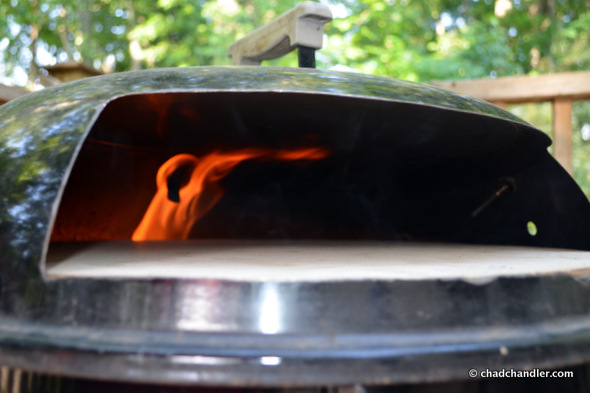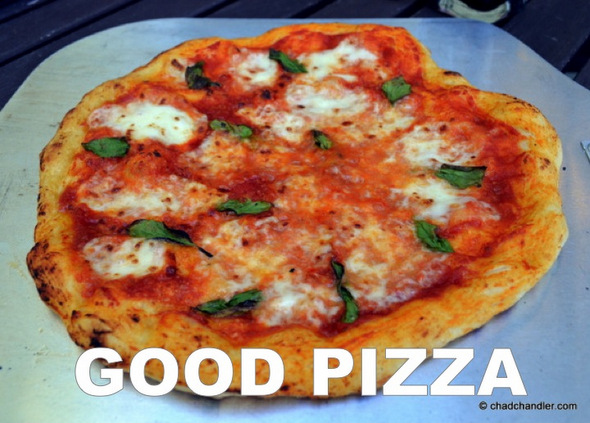Most people seem to equate pizza with Chinese food in the sense that it’s one of those things that’s cheaper and easier to buy from someone else than make at home. That’s not true at all. I can make four 14″ pizzas at home for about $12—that includes all ingredients and fuel. Sure, there’s some opportunity cost involved when you factor in the preparation and cooking time, but it’s pretty fun to manage my homemade oven, especially on cool nights.
Backstory
I remember when the wife and I first tried to make pizza at home. Back then, I knew nothing about dough. After experimenting with batches of homemade mozzarella, we made this pizza with home-grown tomatoes and basil and thought it was some kind of achievement. In retrospect, it was dense, doughy, and almost flavorless. I knew there had to be a better way.

Dealing with a baking stone was a pain in the ass. There’s nothing quite like the hell of running your oven at maximum temperature for 90 minutes in the summertime in the southeast. If you get any spillage on the stone, you end up with a smelly house at best, and a smelly house and cracked pizza stone at worst. We eventually ditched the stone and started buying pre-baked crust like Boboli. Those crusts allowed us to make pizza on impulse. We experimented with various cheeses, sauces, and toppings and had fun doing it. We still sometimes make an occasional white pie with pre-baked crust, but this method never really scratched my itch for great pizza.
As I got older, I started losing my taste for chain pizza. I don’t know if my palate refined or if everyone just started incorporated that movie theater popcorn butter into everything, but all I taste anymore is fake garlic butter oil and cloyingly sweet pizza sauce. I’ll eat it in a bind—it’s still pizza after all—but I prefer something of higher quality. I wanted to make my own pies, but I was held back by my failure with dough preparation.
Over the next few years, I spent a lot of time learning about bread baking. I experimented with basic white bread, French bread, braided challah, and I finally turned the corner when I mastered no-knead artisan bread (learn more). It took a long time until I understood the minutiae of dough preparation that recipe writers take for granted; things like how to define wet versus sticky, dry versus springy, and how to mitigate when your dough is not quite right. They assume you know these things, and they never really tell you how to tell if you’re doing it wrong. It’s one of many frustrating aspects of cooking from recipes.
Homemade Pizza Oven

Once I learned how to work with dough, I figured I’d try my hand at homemade pizza again. My desire to make pizza myself is mostly due to the fact that there’s no great pizza in the city where I live. When people around here rave about pizza, they’re comparing it to the $5 Hot-N-Ready pies from Little Caesar’s. I wanted to aim a little higher.
My favorite types of pizza are wet Neapolitan-style and thin NY-style. I knew that I wanted to make a hybrid of both of these styles, so that meant that I needed temperatures higher than a standard oven can produce. I also have a soft spot for thin, sliced provolone pizzas like they make at Davenport’s Pizza Palace in Birmingham, Alabama (it’s take on Chicago’s tavern-style thin crust pizza, including the square-cut slices). It’s one of the restaurants I always try to visit when I’m in town visiting family. That pizza doesn’t require very high temperatures, but it does require steady ones. So after a lot of consideration and consternation, I built a hybrid wood/coal-fired pizza oven that sits on top of my Weber kettle grill. It reaches very hot temps but can also be backed down to hold a steady fire. It’s the best of both worlds.
LINK: Learn more about the project and how to build your own pizza oven.
Pizza-Making Tutorial
Since I’ve blogged the results of my homemade pizza oven, I’ve had several people comment and/or email me asking for more details. I’m pleased that many have experienced the same success that I did. I use this blog primarily as a web-based scrap book and recipe tin of sorts, so it’s always interesting to me when other people stumble upon my creations and get some satisfaction from them.

To help others who might want to build a similar pizza oven, I’ve actually catalogued my cooking process in a step-by-step tutorial. I tried to go into detail the way other bloggers never really do in their instructions, so feel free to take a look. The post details how to set up the oven, prepare the dough, cook the sauce, and top the pizza. You will also find links to videos and recipes on other websites that will help you to hone your skills.
LINK: Learn how to cook perfect pizza in a homemade kettle grill pizza oven.
Varieties Of Pizza
By playing around with crust recipes and the heat in the oven, you can produce different varieties of pizza. Change up the sauce and the toppings, and you can mimic pretty much any style of pie out there. Here are a handful of examples of pizzas that the wife and I like to make.
Click any image to open the gallery and then navigate with your arrow keys. Press escape to back out of the gallery. On mobile, swipe through the images in portrait view and exit the gallery by clicking on the white X in the top-left corner.
This is a hybrid Neapolitan/NY-style Margherita pizza with fresh mozzarella. I probably used a little too much cheese, but it turned out pretty good. The crust was crunchy, yet airy. Check out that leopard spotting on the bottom.
This is a hybrid Neapolitan/NY-style Tartufo salami and mild Italian sausage pizza with a mixture of torn, fresh mozzarella and freshly shredded, low moisture mozzarella/provolone blend. I was cleaning out the fridge with this one. This dough ball was stubborn when it came to stretching. Since it was a bit thick, it held up to lots of toppings. The downside is that I had to cook it longer and the bottom of the crust got a little charred.
This is a Davenport’s-style pepperoni, salami, and Italian sausage pizza (half with olives) with sliced provolone. The crust is different than what they serve at Davenport’s Pizza Palace in Birmingham, Alabama, but it has the same scald-the-roof-of-your-mouth quality. This came out very thin and crispy.
This is a Davenport’s-style pepperoni pizza with sliced provolone. You can see how thin the dough is, and yet how airy the crust remains around the edges.
These are three NY-style pizzas cooked at high temperature. Two are red- and one is white-based. As the oven loses heat throughout the cook, the pizzas will bake longer at lower temp. That means they can hold up to more toppings than when they’re thin and bubbling and likely to burst. So we start with thin, sparsely topped pies and move to more densely topped ones. Notice how the toppings migrate to the center of the pizza. If you’re not careful, the center will get too soupy, leak through to the hot stone, and scorch the bottom of the crust. Sorry for the picture quality. This was in a drizzling rain on an overcsast Sunday.
Here are some other random pictures of pizzas we’ve made over the past few months. These include Neapolitan, NY-style, and hyrbid Neapolitan/NY-style pizzas. The specific styles are listed in the image captions.

























































